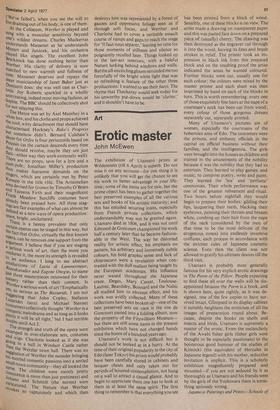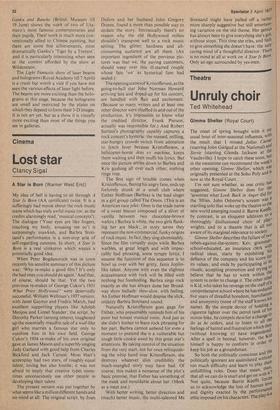Art
Erotic master
John MeEwen
The exhibition of Utamaro prints at Wildenstein (till 6 April) is superb. Do not miss it on any account—for one thing it is unlikely that you will get the chance to see his work to better advantage in your lifetime; some of the items are for sale, but the prime object has been to gather together the best preserved examples of all the various sets and books of his artistic maturity ; and this has entailed securing loans, especially from French private collections, which understandably may not be granted again. Utamaro died in 1806, and it was not until Edmond de Goncourt championed his work half a century later that he became fashionable in the West. The way he distorted reality for artistic effect, his emphasis on pattern, his arbitrary and immensely subtle colours, his bold graphic sense and lack of chiaroscuro were a revelation when contrasted with the dull realism being taught by the European academies. His influence never waned throughout the Japanese craze. Degas, Mary Cassat, ToulouseLautrec, Beardsley, Bonnard and the Nabis all studied him to obvious effect, and his work was avidly collected. Many of these collections have been broken up—one of the best preserved sets on view is the one de Goncourt pasted into a folding album, now the property of the Fitzwilliam Museum— but there are still some items in the present exhibition which have not changed hands since the boom of a hundred years ago.
Utamaro's work is not difficult but it should not be looked at in a hurry. At the time of their original Popularity in the city of Edo (later Tokyo) his prints would probably have been carefully stored in cabinets and lacquer chests and only taken out for periods of leisured contemplation, not hung on a wall to attract a casual glance. And to begin to appreciate them one has to look at them in at least the same spirit. The first thing to remember is that everything you see has been printed from a block of wood. Sensibly, one of these blocks is on view. The artist made a drawing on transparent paper and this was pasted face down on a prepared piece of (usually) cherry. The drawing was then destroyed as the engraver cut through it into the wood, leaving its lines and brush strokes in relief. The printer took an impression in black ink from this prepared block and on the resulting proof the artist indicated the areas he wanted coloured. Further blocks were cut, usually one for each colour ; the colours were mixed by the master printer and each sheet was then imprinted by hand on each of the blocks in turn. This is worth remembering: every one of those exquisitely fine hairs at the nape of a courtesan's neck has been cut from wood; every colour of those gorgeous dresses separately cut, separately printed.
Many of Utamaro's pictures are of women, especially the courtesans of the bohemian area of Edo. The customers were the princes, and embassy officials in the capital on official business without their families, and the intelligentsia. The girls were brought into the houses as children and trained in the amusements of the nobility because it was the nobility that they had to entertain. They learned to play games, and music, to compose poetry, write and paint. They learned the 'tea' and 'perfume' ceremonies. Their whole performance was one of the greatest refinement and ritual. Two hours before nightfall they would begin to prepare their bodies gilding their lips, lacquering their teeth, blacking their eyebrows, painting their throats and breasts white, combing up their hair from the nape of the neck (considered by the men of that time to be the most delicate of the erogenous zones) into endlessly inventive coiffures, each process in accordance with the strictest rules of Japanese cosmetic science. Even then the client was not allowed to gratify his ultimate desires till the third visit.
Utamaro is probably most generally famous for his very explicit erotic drawings in The Poem of the Pillow. People expecting to find these all over the walls will be disappointed because the Poem is a book, and is shown here, quite rightly, as it was designed, one of the few copies to have survived intact. Glimpsed in its display cabinet it suitably heightens the eroticism of all the images of preparation round about. Because, despite the books on shells and insects and birds, Utamaro is supremely a master of the erotic. From the melancholy of the Awabi fisher girls (fisher girls were thought to be especially passionate) to the boisterous good humour of the studies of Kintocki (the equivalent of Hercules in Japanese legend) with his mother, seductive invitation is implicit. This is a scholarly exhibition magnificently prepared and mounted—if you are not seduced by it as thoroughly as Utamaro and his friends were by the girls of the Yoshiwara there is something seriously wrong.
Japanese Paintings and Prints—Schools of
Ganku and Buncho (British Museum till 19 June) shows the work of two of Utamaro's most famous contemporaries and their pupils. Their work is much more conventionally allied to Chinese painting, but there are some fine achievements, most dramatically Ganku's 'Tiger by a Torrent', and it is particularly interesting when seen in the context afforded by the show at Wildenstein.
The Light Fantastic show of laser beams and holograms (Royal Academy till 7 April) is a crush byt worth a visit if you have not seen the various effects of laser light before. The beams are more exciting than the holograms at this stage, because the holograms are small and restricted by the plates on which they depend to form their 3-D images. It is not art yet, but as a show it is visually more exciting than most of the things you see in galleries.







































 Previous page
Previous page